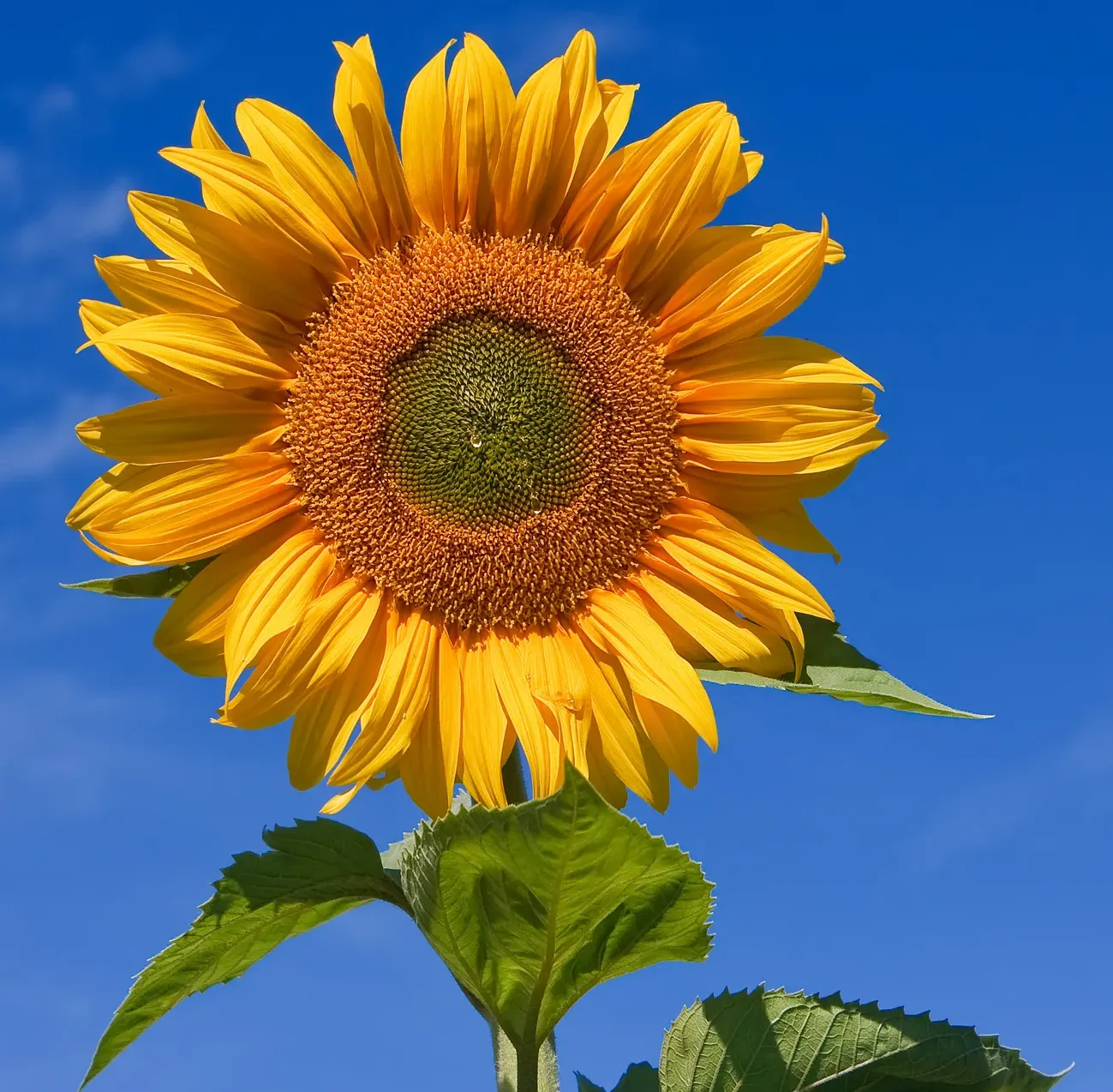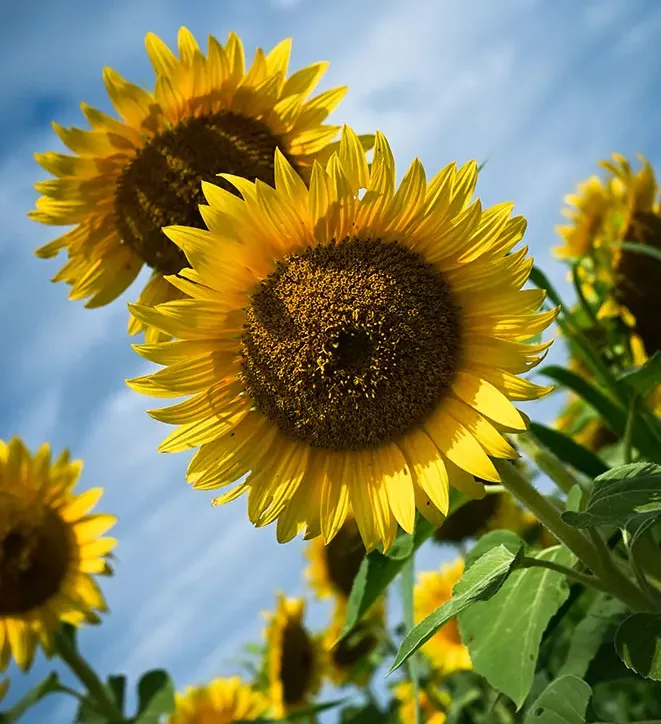Growing Sunflowers: When to Plant and How to Grow Sunflowers
No plant says summer like a sunflower. The bright yellow blooms are like a smile on a stalk. Growing sunflowers is easy because they’re heat tolerant, pest resistant and fast growing. They’re native to North America so they can adapt to conditions in most locations.
You can use them for cut flowers, leave them on the stalk for a gorgeous outdoor display in your garden, or harvest and eat their seeds. Here’s how to grow sunflowers.

Sunflower plants, like this Del Sol hybrid, are sun worshipers that grow best in spots that get six to eight hours of direct sun per day.
Sunflowers
Sunflowers are annual plants. They look like giant daisies, with bright yellow (and sometimes red or brown) petals radiating from brown centers that ripen into a head filled with seed.

Sunflowers are tall, tough plants, with some varieties reaching 14 feet in height. Some smaller varieties, as short as a foot tall, can fit in pots or small gardens. Many varieties attract bees and birds who dine on sunflower nectar and seeds, making them an ideal choice for a wildlife or pollinator garden.
Botanical Name: Helianthus annuus
Common Name: Sunflower
Hardiness Zones: 2 to 11
Bloom Time: Most sunflower varieties bloom for several weeks in midsummer.
Planting Sunflowers
Here's how to choose the right spot and the right place for your plants.
- Sunflowers are sun worshipers that grow best in spots that get six to eight hours of direct sun per day.
- They have long tap roots that need to go several feet into the ground, so sunflower plants prefer loose, well-drained, somewhat alkaline soil with a pH of 6.0 to 7.5.
- Sunflowers are heavy feeders, so they’ll be healthiest and generate the most blooms in nutrient-rich soil that has had compost or other organic matter mixed into it.
- Growing sunflowers in pots is possible if you choose a smaller variety, like "Short Stuff" or "Teddy Bear." Be sure the pot is deep enough to accommodate their tap root.
- If you’re growing one of the giant varieties that top 10 feet in height, plant them in a sheltered location or along a fence so they’re protected from the wind. Otherwise, a gust of wind could tip them over.
When to Plant Sunflowers
- Plant seeds after the danger of spring frost has passed and the soil temperature is at least 60 degrees. This will be between March and May, depending on where you live.
- You can get starter plants at a nursery or home improvement store, but growing sunflower plants is easiest if you grow them from seed sown directly into the ground. More varieties of sunflowers are available to you if you grow from seed. Growing sunflowers from seed is super easy, too.
How to Plant Sunflower Seeds
- Plant the seeds no more than an inch deep and about 6 inches apart. Thin the seedlings once they hit 6 inches tall, leaving the strongest plants about 12 inches apart.
- For continuous blooms, stagger your planting, sowing a new row of seeds every two to three weeks, beginning in the spring. Succession planting, as this is called, will keep you supplied with continuous blooms until first frost.
- How long does it take for sunflowers to grow? From the time you put the seed in the soil to bloom ranges between 80 and 120 days, depending on the variety.
Caring for Sunflowers
- When the plant is small, water the area around the roots, about 4 inches from the plants.
- Once the plant is established, water deeply but infrequently to encourage the plant to grow deep roots. Water once a week with several gallons of water per plant, more often if the weather is very dry or very hot.
- Tall varieties may need support so they don’t topple under the weight of their blooms. Bamboo or other types of wood stakes work well.
Pests and Diseases
Fungal diseases like downy mildew, rust and powdery mildew can infect the plants. Spray infected leaves with a general garden fungicide.
Harvesting Sunflower Seeds
The brown middle of the sunflower will mature into a seed head after the petals fall off. You can harvest them and eat them (seeds make a nutrient-rich snack), or save the seeds to replant next year’s garden. If you’re growing sunflowers to save and eat the seed, do the following:
- Let the flower dry on or off the stem until the back of the head turns brown and the seeds are plump. Once the petals of the sunflower begin to lose their color and the head begins to droop from the weight of the copious seeds, it will take three to four days before the seeds can be easily extracted.
- To keep birds and squirrels from getting the seed, you’ll need to cover the flower heads with garden fleece, cheesecloth or a paper bag after the seed heads mature and the petals fall off the blooms.
- Cut the head off the plant leaving about 6 inches of stem. Place the head in a container to catch loose seeds.
- To remove the seeds, brush your hand over the seed head, knocking out the seeds.
- Once harvested, remove any damaged or discolored seeds. Wash seeds thoroughly and allow to dry before eating.
- If you’re saving the seeds to plant, store them in an airtight container in a cool, dry place until planting time.
Recommended Varieties
There are many types of sunflowers, ranging from giants that reach 14 feet or higher to dwarfs that stay under a foot tall. Here are some of our favorites.
'Russian Mammoth' is the traditional giant sunflower, an aptly named variety that can grow to more than 12 feet tall with blooms the diameter of dinner plates. Its seeds are good for snacks for you or birds.
'Autumn Beauty' is a gorgeous cultivar that grows branching stems of blooms in tones of yellow, orange, bronze and red. Blooms are 4" to 6" across on plants that grow to 6 feet tall.
'Lemon Queen' has pale yellow blooms with chocolate brown centers that are 4" to 5" in diameter. Plants are multibranched and grow to 6 feet tall.
'Teddy Bear' is a tiny variety that grows just 2 feet tall. This small sunflower is ideal for containers and small gardens. Its soft, fluffy gold blossoms are 6 inches across and make good cut flowers.
Grow sunflowers in a pot or grow a sunflower forest with this collection of dwarf and mega varieties.
Garden Design Suggestions
- Some varieties of sunflowers can get very tall and shade other plants, so don’t plant sun-loving companion plants too close.
- Tall varieties of sunflowers work best as a screen, at the back of a border bed, or along a fence.
- Shorter varieties can be grown in the middle of a border or in pots.
Cutting Sunflowers for Bouquets
- Cut flowers early in the morning, before heat has stressed the plants. Harvesting blooms in the middle of a hot day can cause the flowers to wilt prematurely.
- For sunflower varieties that branch into multiple stems, cutting the main stem of the plant before its bud has opened will encourage the plant to make more blooms on the sides of the stem. More flowers is good.
- Handle cut flowers gently so their petals don’t fall off. Cut sunflowers will last about a week in water at room temperature.
How to Roast Sunflower Seeds
Roasting sunflower seeds will enhance the flavor and make it easier to remove the hull when snacking.
- To prepare seeds for roasting, place them in a bowl and cover with water. Add 1/4 cup of kosher salt per quart of water used, stir, cover and allow to rest overnight.
- The next day, drain water and pat seeds dry with a cloth or paper towel.
- Spread seeds evenly on a baking tray and place in a 300 degree oven for 35-40 minutes until seeds begin to brown and the shells start to crack.
- Allow seeds to cool completely before serving. Seeds may be hulled before serving with a fair bit of effort, but the back porch tradition of cracking the shell with one’s teeth to extract the flavorful nut within is a pleasure in its own right.
- Store roasted sunflower seeds for up to one month in an airtight container. If you have more seeds than you can eat in that time, raw seeds may be stored in an airtight container in a cool location for up to one year without significant loss of quality.










